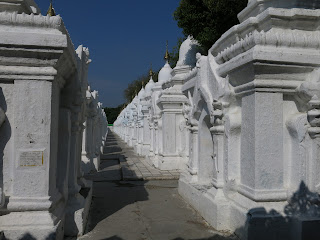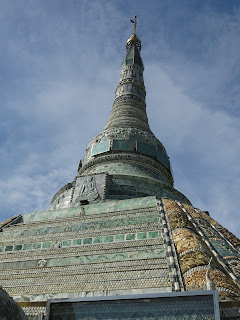Myanmar, formerly known as Burma, stretches from the Andaman Sea in the south, well up into China in the north, sandwiched between Thailand and India. From 1962 to 1988 the country was isolated from the rest of the world by its dictator, and the infrastructure suffered badly. You can see abandoned buildings from the British occupation wherever you go. But first, lets look at some Art in the airport at San Francisco:
 |
| Thinking of Balmy Alley by Rigo, 1999 |
 |
| Sanctuary by Juana Alicia and Emmanuel Montoya, 2000 |
 |
| Mondrian Meets the Beatles by Kota Ezawa, 2017 |
A layover in Kunming, China, did not yield any Art, but the terminal structure was certainly artistic.
There are seemingly countless Buddhist shrines of all sizes and shapes throughout the city. I could not keep track of them all.
One day I walked to the bank of the Yangon River, where I found the wholesale banana market, as well as the markets for sugar cane and coconuts.
Upriver, was the boat depot and fish market.
I spent a day in Bago, about fifty miles northeast, which has some very nice temples.
Then I flew to Mandalay, about 400 miles north. A new city, built in 1857 when it became the national capital, it was the last royal capital as the British took over in 1885. It is both the economic center of Upper Myanmar, and the cultural center of the whole country, with the most monks. Yes, monks are everywhere begging from stores, street stalls, pedestrians, and passing cars. But that's what the religion is about, apparently. I found varied scenes around the city.
It takes all day, depending on the water-level, to take the boat from Mandalay down to Old Bagan. A very pleasant day, interrupted by a visit to a pottery shop along the way. While the tourists came to watch them make large water pots on foot-powered equipment, the pots were for use around the country, where you can always find a pot of water, if you are thirsty. They had very little to sell the tourists, except crude little animals.
Old Bagan is an ancient city and a UNESCO World Heritage site with more than 3,500 religious structures within the 16 square miles. It was still Thadingyut and this was to big weekend. Mostly, everyone goes to their parents and have family get-togethers and light fire-crackers, candles, and sky lanterns. The old temples seemed to swarm with visitors.
And then it was time to leave Myanmar. Next stop: Singapore.

















































































